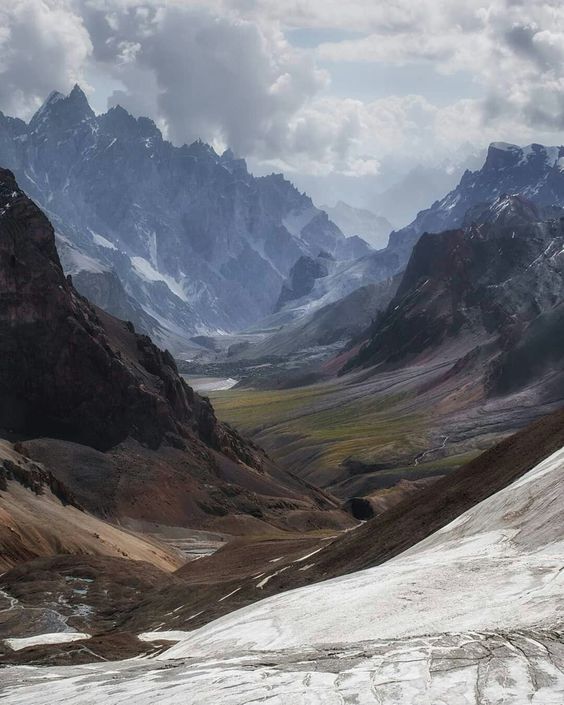Bundok sa Puso (boon dók sa poo sò)
Bundok sa Puso has been forming for hundreds of millions of years. One of the greatest and most recent events was when the dragon pet of the Gods was thrown out of the heavens and into the eastern end of the mountain range, creating Dragon Spire Mountain Dragon Spire Mountains. After that happened, dragon eggs were hidden all over the mountain range and many years later they all began to hatch.
For centuries the dragons called the mountain range home, saturating the land with powerful magics. Some of that magic still radiates throughou the land today.
At nearly 5,000 miles long, the Bundok sa Puso touches nearly all kingdoms on the continent. It is also the source for all of the water, including the Malawak Ilog
Geography
The Bundock sa Puso are the longest continental mountain range in the world, forming a continuous highland along the western edge of the continent. The range is 7,895 km (4,905 mi) long, 500 to 900 km (310 to 559 mi) wide, and has an average height of about 10,000 m (32,808 ft). The Bundock sa Puso extend from east to west through seven countries:
Along their length, the Bundock sa Puso are split into several ranges, separated by intermediate depressions. They are the location of several high plateaus—some of which host major cities such as (add cities). The Lalamunan (throat) plateau is the continent's second-highest after the Palad (palm) plateau. These ranges are in turn grouped into three major divisions based on climate: the Tropical Puso, the Dry Puso, and the Wet Puso.
Ecosystem
The climate in the Bundok sa Pusa varies greatly depending on latitude and altitude. The temperature, atmospheric pressure and humidity decrease in the higher elevations. The western section is rainy and cool, the central section is dry. The eastern section of the mountain are typically rainy and warm, with an average temperature of 22 °C (71.6 °F). The climate is known to change drastically in rather short distances. Rainforests exist just kilometres away from the snow-covered peaks. The mountains have a large effect on the temperatures of nearby areas. The snow line depends on the location. It is at between 5,000 and 6,800 m (16,404 and 22,309 ft) in the tropics, rising to 5,800–7,200 m (19,028–23,622 ft) in the drier mountains south to eastern before descending to 3,500 m (11,482 ft).
Localized Phenomena
Although not proven yet, it is believed that the mountain range is the nexus of all the magical power on the planet.
Fauna & Flora
Flora
The Bundok region cuts across several natural and floristic regions, from tropical to cold, windy to wet and passing through a hyperarid desert. The mountains are typically dominated by deciduous woodland, shrub and xeric vegetation, reaching the extreme in the slopes near the virtually lifeless desert. About 45,000 species of vascular plants live in the Bundoks, with roughly half being endemic to the region, surpassing the diversity of any other known mountain range.Fauna
The Bundok sa Pusa are rich in fauna: With almost 2,500 species, the Bundok are the most important region on the continent for amphibians. The diversity of animals in the region is high, with almost 800 species of mammals, more than 2,000 species of birds, more than 400 species of reptile, and almost 700 species of fish.Natural Resources
Centuries ago, the Dwarven population in the area discovered a vast wealth of minerals.
Gold and silver is by far the most abundant, but copper, iron, zinc and coal have been found in large deposits throughout the entire mountain range. Granite and marble have been quarried along the range and many species of trees are harvested year round by any that dare face the hardships of being on the mountain.
The Dwarves have discovered many locations of fertile land in which they grow all the ingrediants for their various alcohols.
History
This mountain range is the result of millions of years of shifting tectonic plates, erosion and the bombardment of astral debris. At the core of many of the mountains are huge and ancient glaciers that were formed during the creation of the world.
Tourism
These mountains are home to many species of animals and plants. Only a handful of Dwarven Clans call the mountains home and even fewer other races. The only time that other humanoids come to these mountains is in search of some miracle remedy.
Alternative Name(s)
Heart Mountain
Type
Mountain Range
Included Locations
Related Tradition (Primary)
Remove these ads. Join the Worldbuilders Guild









Comments